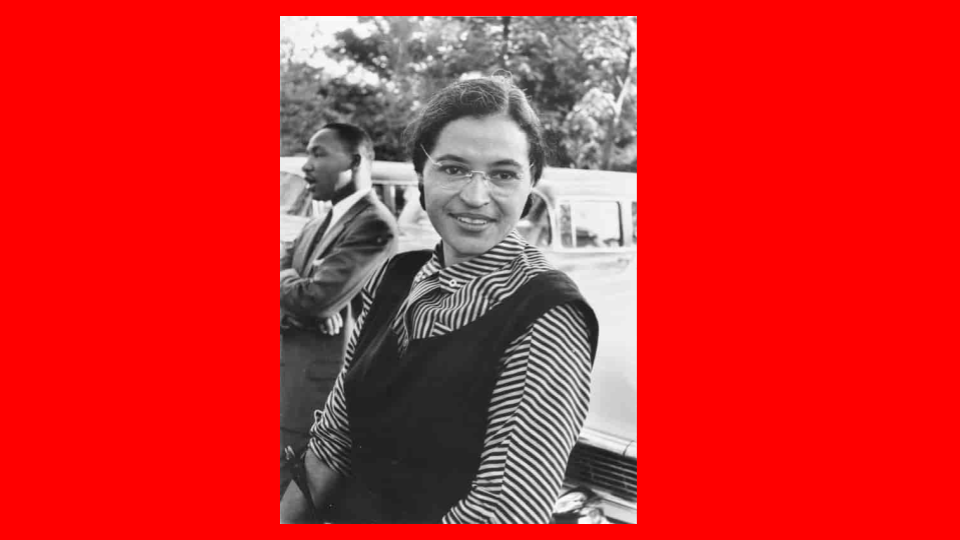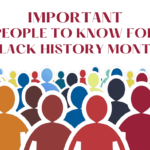Rosa Parks was born on February 4, 1913, in Tuskegee Alabama. Her family was not very well off, but she was able to study. As a child, she remembered the bus coming for the white students and taking them to their new school, while she, like most other black children, walked to their run-down schoolhouse. She loved to sew and had a talent for making quilts. She dropped out of high school to care for her sickly grandmother.
Rosa married Raymond Parks, a barber from Montgomery Alabama, in 1932. Raymond was a member of the NAACP (National Association for the Advancement of Colored People) and he encouraged her participation in meetings. He also encouraged Rosa to finish her high school education which she did in 1933.
Rosa worked various jobs to help make ends meet. She would clean people’s houses, sew or repair clothes, and even worked as an aide in a hospital. Wherever she went, she was known as a hard worker and the people loved and respected her.
In 1943, she was elected secretary for the NAACP. She would often investigate the claims of wrongdoing. She was frustrated with the mistreatment she was seeing. The day came when she could take no more.
The buses in Montgomery had been segregated since 1900. The law originally stated that the bus drivers could assign seats based upon race, but that no one had to move or give up their seat. Unfortunately, that part of the law had been forgotten. The first four rows of the bus were designated for white customers and the back rows were for the black customers. As the bus filled, the middle section would be divided based upon the people getting on the bus. If more whites boarded, the black customers were asked to move back or stand up. If they didn’t like those options they could leave the bus.
On December 1, 1955, Rosa Parks boarded the bus on her way home after a long day at work. She sat in the middle section as the white section was practically empty. More white people boarded, so the bus driver moved the sign that divided the sections behind Rosa. He asked her to move and she refused. He threatened to call the police, and she remained seated. Rosa Parks was arrested for disorderly conduct for her act of civil disobedience. That same evening the NAACP President and one of her white employers came to bail her out of jail.
Rosa said in her autobiography: People always say that I didn’t give up my seat because I was tired, but that isn’t true. I was not tired physically, or no more tired than I usually was at the end of a working day. I was not old, although some people have an image of me as being old then. I was forty-two. No, the only tired I was, was tired of giving in.
This infuriated the black people of Montgomery (and even some of the white people). This began the Montgomery Bus Boycott. Rosa was put on trial and found guilty. There were already cases that were being appealed federally about bus segregation so the bus boycott continued just over a year until one of those cases ended. The Supreme Court ruled that bus segregation was unconstitutional. When they saw that this boycott was going to take some time, the Montgomery Improvement Association was founded to support the efforts of the activists. They elected a new president, Martin Luther King Jr.
As a result of her arrest, Rosa Parks was fired. Her husband was allowed to keep his job as long as he didn’t talk about his wife and the arrest, but that was impossible since she was becoming a hero to the civil rights movement. He soon lost his job as well. They left Alabama and moved to Detroit. Once in Detroit, Rosa found a job working for John Conyers – an African-American US Representative from Michigan. She continued to fight with the civil rights movement throughout her life.
Rosa Parks died on October 24, 2005. She was the first woman and only the 2nd black person to lie in honor at the Capitol rotunda. She had been given many awards including the Martin Luther King, Jr. award, The Presidential Medal of Freedom, and the Congressional Gold Medal. She has many memorials including highways, transportation stations, libraries, and parks. She is considered the mother of the freedom movement.
For more information, click here.





